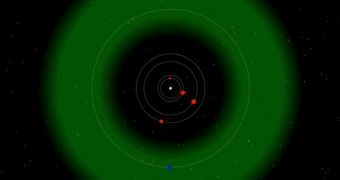Astronomers at the NASA Ames Research Center (ARC) in Moffett Field, California, have released a new list of extrasolar planets yesterday, February 26. All of these alien worlds have been detected by the NASA Kepler space telescope, and are already confirmed.
With the new bonanza of detections, the total number of known and confirmed exoplanets exceeds the 1,700 mark. Overall, Kepler has detected more than 3,500 potential candidates to date, many of which still await confirmation. According to analysts, around 85 to 90 percent of detections will end up being confirmed by other ground- and space-based observatories.
The 715 new planets were found orbiting a total of 305 stars, for an average of two exoplanets per star. However, astronomers found many instances of multiple-planet star systems, boasting a layout that is very similar to the one we see in our solar system. Not many such systems were previously known.
Another significant aspect of the announcement is that 95 percent of the newly-verified worlds are smaller than Neptune, or smaller than four times the size of Earth. Until now, it appeared that planets larger than Jupiter and Saturn dominated other star systems. Super-Earths were also very common.
“The Kepler team continues to amaze and excite us with their planet hunting results. That these new planets and solar systems look somewhat like our own, portends a great future when we have the James Webb Space Telescope in space to characterize the new worlds,” said John Grunsfeld.
The official holds an appointment as an associate administrator with the Science Mission Directorate at NASA Headquarters, in Washington DC. He explained that verifying so many planets in such a short time was possible through the use of a new statistical method that was only recently developed.
The new verifications were conducted on a batch of exoplanetary candidates Kepler identified between May 2009 and March 2011. The investigation was carried out by an ARC team led by planetary scientists Jack Lissauer.
“Four years ago, Kepler began a string of announcements of first hundreds, then thousands, of planet candidates – but they were only candidate worlds. We've now developed a process to verify multiple planet candidates in bulk to deliver planets wholesale, and have used it to unveil a veritable bonanza of new worlds,” Lissauer explains.
The new study has also revealed multiple commonalities between star systems in the Milky Way and the solar system. Most systems featuring multiple planets contain small worlds that orbit their parent stars in flat and circular orbits, just like we see with Earth, Mars, Mercury and Venus.
“From this study we learn planets in these multi-systems are small and their orbits are flat and circular – resembling pancakes – not your classical view of an atom. The more we explore the more we find familiar traces of ourselves amongst the stars that remind us of home,” says SETI Institute scientist Jason Rowe, a co-leader of the new study.
A series of papers providing more details about the newly-verified worlds will appear in the March 10 issue of the esteemed Astrophysical Journal.

 14 DAY TRIAL //
14 DAY TRIAL //